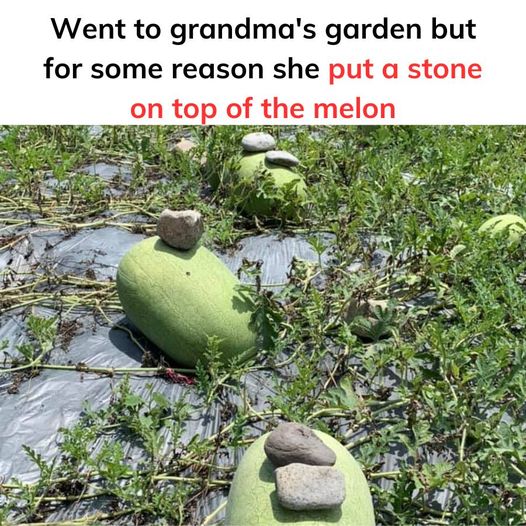When I ventured into my grandmother’s garden, I was puzzled to see stones placed atop the melons. Curious, I asked her about this unusual gardening technique. She smiled and explained the reasons behind it, which turned out to be a blend of tradition and practical wisdom.
1. Bird Deterrence
One of the primary reasons for placing stones on melons is to deter birds. Birds often peck at the fruit, causing significant damage. By placing a stone on top of the melons, it creates an unstable surface for the birds, making it difficult for them to land and peck at the fruit. The instability scares them away, thus protecting the melons from being eaten.
2. Marking Ripe Melons
Farmers and gardeners use stones to mark melons that are ripening. This simple method helps them keep track of which melons need to be harvested soon. Watermelons usually take about a month to ripen after they start fruiting. By placing a stone on a melon that is nearing ripeness, it becomes easier to monitor and manage the harvesting process.
3. Sunlight Management
Another reason for placing stones on melons is to protect them from excessive sunlight. Melons exposed to too much direct sunlight can develop sunburn or become overripe too quickly. The stones act as a small shield, providing some shade and reducing the risk of sun damage. This technique helps in maintaining the quality and longevity of the fruit.
4. Ensuring Even Growth
Stones can also play a role in ensuring the even growth of melons. As melons grow, they tend to expand in different directions. Placing a stone on top of them can help in distributing the weight more evenly, encouraging a more uniform shape. This is particularly important for commercial growers who need their produce to have a consistent appearance.
5. Improving Melon Quality
Finally, the use of stones can improve the overall quality of the melons. By controlling the growth pattern and protecting the fruit from external factors like birds and excessive sunlight, the melons can develop better texture, flavor, and appearance. This traditional method has been passed down through generations and remains effective in ensuring a good harvest.
Exploring Traditional Gardening Techniques
Grandma’s garden is not just a place for growing fruits and vegetables; it’s a living repository of traditional knowledge and techniques that have been honed over centuries. These methods, while seemingly simple, often have scientific reasoning behind them. They reflect a deep understanding of nature and an intuitive approach to gardening.
For instance, companion planting is another technique she uses. By planting certain crops together, they can benefit each other in terms of pest control, pollination, and nutrient uptake. Marigolds, for example, are often planted alongside tomatoes because they help repel harmful insects.
Moreover, Grandma uses rainwater harvesting to water her garden. She has set up barrels to collect rainwater, which is then used to irrigate the plants. This not only conserves water but also provides the plants with natural, untreated water, which they seem to thrive on.
Sustainability in the Garden
Sustainability is at the heart of Grandma’s gardening philosophy. She composts kitchen waste to create rich, organic fertilizer for her plants. This not only reduces waste but also enriches the soil with nutrients, promoting healthy plant growth.
She also practices crop rotation to maintain soil fertility. By rotating the crops each season, the soil has time to replenish its nutrients, reducing the need for chemical fertilizers. This method helps prevent soil depletion and maintains the health of the garden ecosystem.
Lessons for Modern Gardeners
Modern gardeners can learn a lot from these traditional practices. While technology and modern methods have their place, incorporating these age-old techniques can lead to a more holistic and sustainable approach to gardening. They remind us that sometimes, the simplest solutions are the most effective.
Incorporating stones on melons might seem quaint, but it is a testament to the ingenuity of past generations. These practices, borne out of necessity and observation, have stood the test of time and continue to be relevant today.
Conclusion
Next time you visit a garden and see stones on melons, you’ll know the multifaceted reasons behind this practice. From deterring birds and marking ripening fruit to managing sunlight and ensuring even growth, these stones play a crucial role in the life cycle of the melons. Grandma’s garden is a treasure trove of wisdom, showing that sometimes, the best way to grow is to look to the past.

